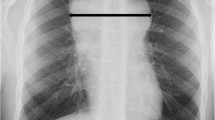Abstract
Advances in diagnostic imaging technology, especially functional imaging modalities like positron emission tomography (PET), have significantly influenced the staging and treatment approaches used for pediatric Hodgkin’s lymphoma. Today, the majority of children and adolescents diagnosed with Hodgkin’s lymphoma will be cured following treatment with non-cross-resistant combination chemotherapy alone or in combination with low-dose, involved-field radiation. This success produced a greater appreciation of long-term complications related to radiation, chemotherapy, and surgical staging that prompted significant changes in staging and treatment protocols for children and adolescents with Hodgkin’s lymphoma. Contemporary treatment for pediatric Hodgkin’s lymphoma uses a risk-adapted approach that reduces the number of combination chemotherapy cycles and radiation treatment fields and doses for patients with localized favorable disease presentation. Advances in diagnostic imaging technology have played a critical role in the development of these risk-adapted treatment regimens. The introduction of computed tomography (CT) provided an accurate and non-invasive modality to define nodal involvement below the diaphragm that motivated the change from surgical to clinical staging. The introduction of functional imaging modalities, like positron emission tomography (PET) scanning, provided the means to correlate tumor activity with anatomic features generated by CT and modify treatment based on tumor response. For centers with access to this modality, PET imaging plays an important role in staging, evaluating tumor response, planning radiation treatment fields, and monitoring after completion of therapy for pediatric Hodgkin’s lymphoma. This trend will likely increase in the future as a result of PET’s superior sensitivity in correlating sites of tumor activity compared to other available functional imaging modalities. Ongoing prospective studies of PET in pediatric patients will increase understanding about the optimal use of this modality in children with cancer and define the characteristics of FDG-avid nonmalignant conditions that may be problematic in the interpretation of tumor activity.






Similar content being viewed by others
References
Hudson MM, Donaldson SS (1999) Treatment of pediatric Hodgkin’s lymphoma. Semin Hematol 36:313–323
Hudson MM, Donaldson SS (2002) Hodgkin’s disease. In: Pizzo PA, Poplack DG (eds) Principles and practice of pediatric oncology, 4th edn. Lippincott, Williams & Wilkins, Philadelphia, pp 637–660
Hudson MM, Poquette CA, Lee J, et al (1998) Increased mortality after successful treatment of Hodgkin’s disease. J Clin Oncol 16:3592–3600
Hudson MM (2003) Pediatric Hodgkin’s therapy: time for a paradigm shift. J Clin Oncol 20:3755–3757
Castellino RA, Blank N, Hoppe RT, et al (1986) Hodgkin’s disease: contributions of chest CT in the initial staging evaluation. Radiology 160:603–605
Rostock RA, Giangreco A, Wharam MD, et al (1982) CT scan modification in the treatment of mediastinal Hodgkin’s disease. Cancer 49:2267–2275
Hanna SL, Fletcher BD, Boulden TF, et al (1993) MR imaging of infradiaphragmatic lymphadenopathy in children and adolescents with Hodgkin disease: comparison with lymphography and CT. J Magn Reson Imaging. 3:461–470
Weiner M, Leventhal B, Cantor A, et al (1991) Gallium-67 scans as an adjunct to computed tomography scans for the assessment of a residual mediastinal mass in pediatric patients with Hodgkin’s disease. A Pediatric Oncology Group study. Cancer 68:2478–2480
Brisse H, Pacquement H, Burdairon E, et al (1998) Outcome of residual mediastinal masses of thoracic lymphomas in children: impact on management and radiological follow-up strategy. Pediatr Radiol 28:444–450
Luker GD, Siegel MJ (1993) Mediastinal Hodgkin disease in children: response to therapy. Radiology 189:737–740
Bar-Shalom R, Valdivia AY, Blaufox MD (2000) PET imaging in oncology. Semin Nucl Med 30:150–185
Bar-Shalom R, Yefremov N, Haim N, et al (2003) Camera-based FDG PET and 67 Ga SPECT in evaluation of lymphoma: comparative study. Radiology 227:353–360
Hueltenschmidt B, Sautter-Bihl ML, Lang O, et al (2001) Whole body positron emission tomography in the treatment of Hodgkin disease. Cancer 91:302–310
Shulkin BL (1997) PET applications in pediatrics. Q J Nucl Med 41:281–291
Jerusalem G, Beguin Y, Fassotte MF, et al (1999) Whole-body positron emission tomography using 18F-fluorodeoxyglucose for posttreatment evaluation in Hodgkin’s disease and non-Hodgkin’s lymphoma has higher diagnostic and prognostic value than classical computed tomography scan imaging. Blood 94:429–433
Wirth A, Seymour JF, Hicks RJ, et al (2002) Fluorine-18 fluorodeoxyglucose positron emission tomography, gallium-67 scintigraphy, and conventional staging for Hodgkin’s disease and non-Hodgkin’s lymphoma. Am J Med 112:262–268
Bangerter M, Kotzerke J, Griesshammer M, et al (1999) Positron emission tomography with 18-fluorodeoxyglucose in the staging and follow-up of lymphoma of the chest. Acta Oncol 38:799–804
James K, Eisenhauer E, Christian M, et al (1999) Measuring response in solid tumors: unidimensional versus bidimensional measurement. J Natl Cancer Inst 91:523–528
Therasse P, Arbuck SG, Eisenhauer EA, et al (2000) New guidelines to evaluate the response to treatment in solid tumors. J Natl Cancer Inst 92:205–216
Langer CJ, Keller SM, Erner SM (1992) Thymic hyperplasia with hemorrhage simulating recurrent Hodgkin disease after chemotherapy-induced complete remission. Cancer 70:2082–2086
Osborne BM, Butler JJ, Gresik MV (1992) Progressive transformation of germinal centers: comparison of 23 pediatric patients to the adult population. Mod Pathol 5:135–140
Nguyen PL, Ferry JA, Harris NL (1999) Progressive transformation of germinal centers and nodular lymphocyte predominant Hodgkin’s disease: a comparative immunohistochemical study. Am J Surg Pathol 23:27–33
Author information
Authors and Affiliations
Corresponding author
Additional information
Supported in part by grants Cancer Center Support (CORE) Grant CA-21765, P01 CA-20180 from the National Cancer Institute from the National Institutes of Health, a Center of Excellence grant from the state of Tennessee, and by the American Lebanese Syrian Associated Charities (ALSAC)
CME activity Please find the CME information and questions at the end of this issue
The author(s) have no financial interest, arrangement, or affiliation to disclose in the context of this CME activity. There is nothing to disclose regarding investigational or “off-label” use of medical devices or other products, or any pharmaceutical agents
Rights and permissions
About this article
Cite this article
Hudson, M.M., Krasin, M.J. & Kaste, S.C. PET imaging in pediatric Hodgkin’s lymphoma. Pediatr Radiol 34, 190–198 (2004). https://doi.org/10.1007/s00247-003-1114-3
Received:
Revised:
Accepted:
Published:
Issue Date:
DOI: https://doi.org/10.1007/s00247-003-1114-3




